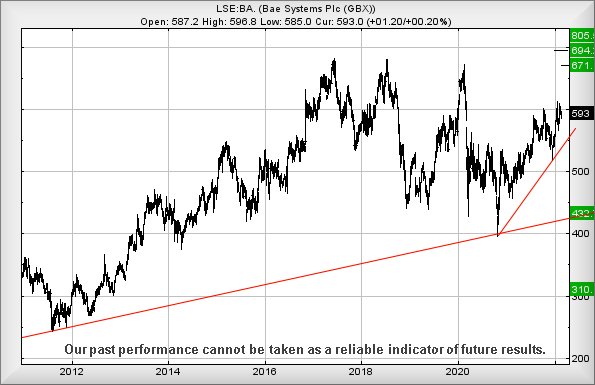Chart analysis: BAE Systems and Qinetiq
23rd February 2022 07:32
by Alistair Strang from Trends and Targets
Independent analyst Alistair Strang runs his eye over shares in two of Britain's top defence contractors, and what they might do next.

It used to be said “the market always knows” and, as a result, we’re looking at some shares this week which should give a clue of impending trouble.
UK defence contractor QinetiQ Group (LSE:QQ.) find themselves in a strange place, their share price (252p at time of writing) looking very like it intends reversal to a bottom of 227p. Whereas for BAE Systems (LSE:BA.) the picture is quite different – but still not frothing at the mouth.
- Friends & Family: ii customers can give up to 5 people a free subscription to ii, for just £5 a month extra. Learn more
- Why reading charts can help you become a better investor
- Market winners from Russian aggression
Presently trading around 593p, BAE needs to fall below 533p to give cause for concern. Movement such as this takes the share price into a region where reversal to an initial 432p looks very possible. Secondary, if broken, is a less likely bottom at 310p. But, in reality, if feels like BAE shall experience some gains fairly soon.

Source: Trends and Targets. Past performance is not a guide to future performance
To convince us, the share needs to close a session above a trigger level of 601p. This criteria appears quite important, calculating as making a visit to 671p a pretty confident ambition. If exceeded, our secondary works out at 694p and, visually, this looks important.
By reaching 694p, the share shall exceed the level of the series of highs since 2017, and we don’t feel over-optimistic by mentioning the price will be in a third target zone, easily capable of a cycle to 805p and a new all-time high.
From a personal stance, it’s easy to hope this is all military posturing, designed to enhance the price of exports from Russia during winter, when demand for gas is highest. Fingers crossed time.
Alistair Strang has led high-profile and "top secret" software projects since the late 1970s and won the original John Logie Baird Award for inventors and innovators. After the financial crash, he wanted to know "how it worked" with a view to mimicking existing trading formulas and predicting what was coming next. His results speak for themselves as he continually refines the methodology.
Alistair Strang is a freelance contributor and not a direct employee of Interactive Investor. All correspondence is with Alistair Strang, who for these purposes is deemed a third-party supplier. Buying, selling and investing in shares is not without risk. Market and company movement will affect your performance and you may get back less than you invest. Neither Alistair Strang or Interactive Investor will be responsible for any losses that may be incurred as a result of following a trading idea.
Disclosure
We use a combination of fundamental and technical analysis in forming our view as to the valuation and prospects of an investment. Where relevant we have set out those particular matters we think are important in the above article, but further detail can be found here.
Please note that our article on this investment should not be considered to be a regular publication.
Details of all recommendations issued by ii during the previous 12-month period can be found here.
ii adheres to a strict code of conduct. Contributors may hold shares or have other interests in companies included in these portfolios, which could create a conflict of interests. Contributors intending to write about any financial instruments in which they have an interest are required to disclose such interest to ii and in the article itself. ii will at all times consider whether such interest impairs the objectivity of the recommendation.
In addition, individuals involved in the production of investment articles are subject to a personal account dealing restriction, which prevents them from placing a transaction in the specified instrument(s) for a period before and for five working days after such publication. This is to avoid personal interests conflicting with the interests of the recipients of those investment articles.